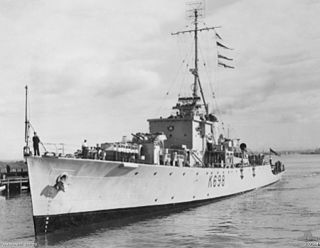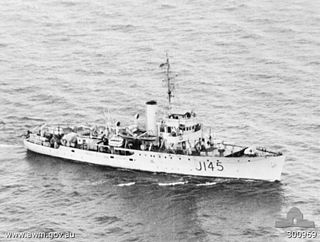Three ships of the Royal Australian Navy have been named HMAS Anzac, after the Australian and New Zealand Army Corps (ANZAC).

HMAS Burdekin (K376) was a River-class frigate that served the Royal Australian Navy (RAN) from 1944 to 1946. She was named for the Burdekin River in Queensland and was one of twelve River-class frigates built for the RAN during World War II.

HMAS Condamine (K698/F698), named for the Condamine River in Queensland, was a River-class frigate of the Royal Australian Navy (RAN). Commissioned in 1946, Condamine served in the Korean War. The ship was paid off in 1955, and sold for scrap in 1961.
Four ships of the Royal Australian Navy been named HMAS Parramatta, for the Parramatta River. The name comes from the Barramattagal people.
Three ships of the Royal Australian Navy (RAN) have been named HMAS Perth after Perth, the capital city of Western Australia.

HMAS Quiberon (G81/D20/D281/F03) was a Q-class destroyer of the Royal Australian Navy (RAN). Although built for the Royal Navy and remaining British property until 1950, Quiberon was one of two Q-class destroyers commissioned into the RAN during World War II. She was passed into full RAN ownership in 1950, and converted into an anti-submarine frigate.

HMAS Quickmatch (G92/D21/D292/F04) was a Q-class destroyer operated by the Royal Australian Navy (RAN). Although commissioned into the RAN in 1942, the ship was initially the property of the Royal Navy. Quickmatch served with both the British Eastern Fleet and British Pacific Fleet during World War II. In the 1950s, the destroyer was converted into an anti-submarine frigate. In 1957, Quickmatch operated in support of Malaya during the Malayan Emergency. The ship remained in service until 1963, and after use as an accommodation ship, was sold for scrap in 1972.
Three ships of the Royal Australian Navy (RAN) have been named HMAS Stuart:
Two ships of the Royal Australian Navy (RAN) have been named HMAS Vampire.
Two ships of the Royal Australian Navy (RAN) have been named HMAS Voyager.
There have been one ship and one shore establishment in the Royal Australian Navy (RAN) named HMAS Waterhen. The first ship originally served under the name HMS Waterhen with the Royal Navy (RN). A British ship and an Australian ship of the name were ordered but later cancelled.
Four ships of the Royal Australian Navy (RAN) have been named HMAS Yarra after the Yarra River in Victoria.

HMAS Lismore (J145/B247/A121), named for the city of Lismore, New South Wales, was one of 60 Bathurst-class corvettes that were constructed during World War II, and one of 20 manned and commissioned by the Royal Australian Navy (RAN) under Admiralty order. During her Australian service, Lismore covered 191,132 nautical miles (353,976 km), and spent the longest period away from Australia of any RAN vessel during World War II: 1,409 days. Serving with the RAN for five years, Lismore later spent twelve years as part of the Royal Netherlands Navy (RNLN), classified as the frigate HNLMS Batjan.

HMAS Platypus was a submarine depot ship and base ship operated by the Royal Australian Navy (RAN) between 1919 and 1946. Ordered prior to World War I to support the Australian submarines AE1 and AE2, Platypus was not completed until after both submarines had been lost, and she was commissioned into the Royal Navy from 1917 to 1919.
HMAS Teal was a Ton-class minesweeper operated by the Royal Navy (RN) and the Royal Australian Navy (RAN).

HMAS Stuart was a British Scott-class flotilla leader. The ship was built by Hawthorn Leslie and Company for the Royal Navy during World War I, and entered service at the end of 1918. The majority of the destroyer's British service was performed in the Mediterranean, and in 1933 she was transferred to the Royal Australian Navy. Although placed in reserve in 1938, Stuart was reactivated at the start of World War II to lead the Australian destroyer force, nicknamed the Scrap Iron Flotilla by German propagandists.
HMAS Vendetta was one of three Daring class destroyers built for and operated by the Royal Australian Navy (RAN). The destroyer was built by Williamstown Naval Dockyard and entered service in 1958. During her early career, Vendetta was deployed to the Far East Strategic Reserve on multiple occasions. In 1965 and 1966, the destroyer undertook deterrence patrols during the Indonesia-Malaysia Confrontation. Along with several runs escorting the troop transport HMAS Sydney to Vietnam, from late 1969 to early 1970 Vendetta was assigned to combat operations, and became the only Australian-built warship to serve in a shore bombardment role during the Vietnam War.

HMAS Yarra, named for the Yarra River, was a River class destroyer escort of the Royal Australian Navy (RAN). The antisubmarine warship operated from 1961 to 1985.

HMAS Yarra (U77), named for the Yarra River, was a Grimsby-class sloop of the Royal Australian Navy (RAN) that served during World War II. Commissioned in 1936, Yarra spent the early part of the war in Australian waters, then was transferred to the East Indies Station in 1940. The sloop operated in the Red Sea, then was involved in the Anglo-Iraqi War and the Anglo-Soviet invasion of Iran. After operating as part of the Tobruk Ferry Service in the Mediterranean during November, Yarra was reassigned to Southeast Asia in response to Japanese attacks. On 4 March 1942, Yarra was attacked and sunk by a force of Japanese cruisers and destroyers while attempting to protect ships withdrawing to Australia.
















